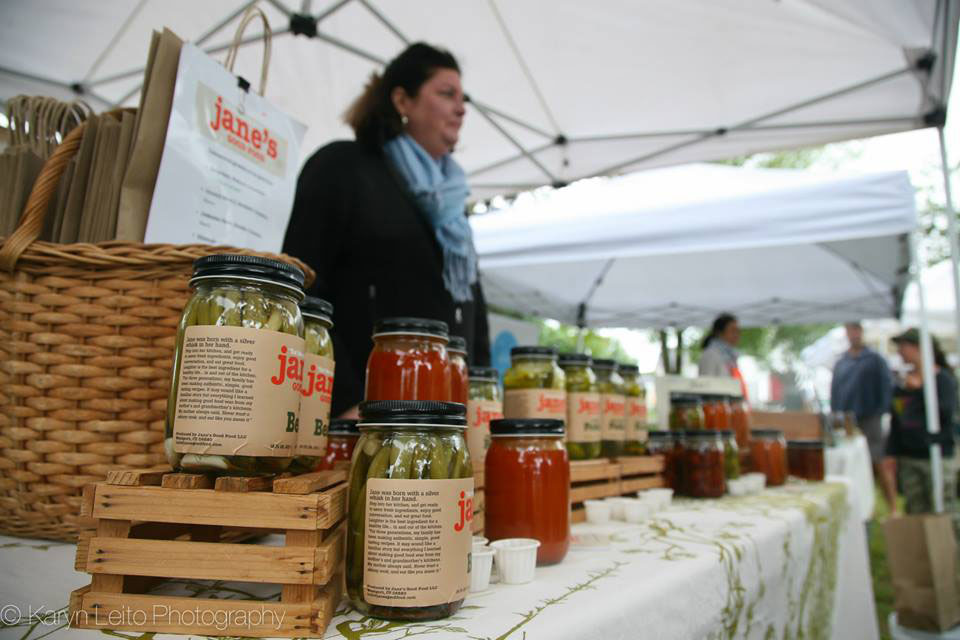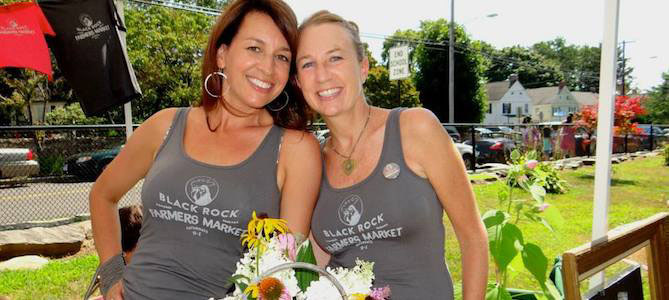It’s almost June, and if you’re neighborhood farmers market isn’t open yet, it will be soon.
Wait, you don’t have a farmers market in your community? If not, it is possible to change that. That’s what Michelle Margo and Karyn Leito set out to do last year. The women, two working mothers who like to eat healthy, live in the Black Rock neighborhood of Bridgeport, Conn. They lamented the lack of a farmers market in their community, so they decided to start one together.
Less than two years since they conceived of the idea, the partners have built Black Rock Farmers Market, which is set to open for its second season on June 20. Black Rock customers are thrilled to have a new gathering place, says Margo. It’s a lively place, with live music and chef-led cooking demonstrations every weekend. Many customers come in the morning and stay until closing at 1 p.m.
Despite it success, this may be a make-or-break season for Black Rock’s market. The partners, who both have jobs and families to juggle, have run it as volunteers so far, and need to find more funding to make it sustainable to operate. We talked to Margo to learn more about how they started the market and their struggles and successes along the way.
Market Research
When Margo and Leito got serious about starting a market, they floated the idea on an active community Facebook page to gauge local interest. “The response was overwhelming,” said Margo. “People said they’ve been wanting something like this for years. That was our first indication that this was something that would fill a need.” When they started their own Facebook page, they got 550 “likes” within 24 hours. “That was in the middle of winter when it was cold and we were thinking, OK, we have to do this.”
Seeking Advice
Margo and Leito networked in the community as they made their plans. They became a part of the Bridgeport Farmers Market Collaborative, a group of six markets created by Bridgeport’s health department and Wholesome Wave, a national nonprofit aimed at getting healthy, locally grown food into the hands of America’s most needy while stimulating local food economies. “They’ve been the guiding force throughout this whole thing,” said Margo. “They really just said, ‘This is how you do it. This is who you have to contact. Here are your next steps.’”
Location, Location, Location
Margo didn’t have to search far for a location for their new market. A local church had been given a piece of property next to the church, and they were looking for a way to use it to serve the community. “We connected with them and they gave us the property to use for the market,” said Margo.
The Vendor Balance
The number of farmers markets in the U.S. has grown by 76 percent since 2008, but that growth has slowed in recent years, which may mean there aren’t enough local farmers to support new markets in some areas. This rings true in the Black Rock area. Finding enough farmers to meet their customers’ expectations was one of the market’s initial challenges.
Margo had an existing relationship with a respected farm in the area who agreed to commit to the Black Rock market. “It helped bring other vendors on board because she vouched for us,” said Margo. Without that relationship, it might not have worked. “There’s a lot of competition out there and a lot of other markets. We’re targeting a lot of the really reputable food vendors and we’re a first year market, they want to wait and see how it goes.”
This year, more local, producer-only farms have signed on. “Some of these even have meat!” said Margo. “We believe it was easier to attract these vendors this year because of the successful first season we had last year.”

Unexpected Challenges
Margo and Leito knew starting a farmers market would be work, but there were a few obstacles that cropped up that they didn’t expect. They didn’t realize how challenging it would be to convince farmers to join the market, for instance.
They also didn’t anticipate how difficult it would be to allow shoppers to pay with SNAP and WIC benefits. For SNAP, they needed to buy an $1,100 EBT machine. For WIC, they found out that only the farmers, not the market, could accept the checks, and each vendor had to be registered with the state’s department of agriculture to participate. “One of our main goals in having this market was to be able to offer fresh produce to people who wouldn’t otherwise have access to it, so that was frustrating. It’s very costly to run these programs that ultimately help people,” said Margo.
Since last season, they were able to secure a grant to cover the cost of the EBT machine, and two farmers have become registered to accept WIC checks.
Market Rewards
So far, Margo and Leito have built the market they envisioned: one that would give their community a new gathering place and better access to fresh, healthy food.
“People have come to us and said, ‘This is amazing. Not only is this a fun thing to do on a Saturday with the family, but I’m finding that we’re eating healthier,’” said Margo. “We’ve seen that the kids who normally would not want to try a certain vegetable all of a sudden like it or want to take it to school for their snack. Watching that change has been really, really gratifying.”
An Uncertain Future
Despite its success, the growing market’s ultimate challenge is finding a sustainable financial model. The demands of running the market on a volunteer basis on top of their regular jobs leave little time for Margo and Leito to fundraise. They were hoping to use the off season to build a model that lets them bring in enough money to hire some help or hire themselves so the workload is sustainable, but it’s not enough yet.
“We’re very concerned about the future of the market,” says Margo. “We’ve invested so much in creating a very successful market, however, we do not have the capacity to continue to run the market on a volunteer basis.”
The struggles of Black Rock Farmers Market aren’t unique. Farmers markets around the country rely on volunteers, grants and sponsors to keep afloat. A good farmers market can strengthen a community’s health and vibrancy and help strengthen local agricultural. If you want to help your local farmers markets succeed, shopping there regularly, rain or shine, is important. If you want to get more involved, the organizers would probably love help on market day or behind the scenes.
Start your own!
If you’re interested in starting a farmers market, check out these resources:
How to Organize and Run a Successful Farmers’ Market (Massachusetts Office of Energy and Environmental Affairs)
How to Start a Farmers Market (USDA)
Amy Leibrock
Blog Editor
RELATED ARTICLES
Is Your State Locavore-Friendly?
Good Growth: Farmers Markets Still on the Rise
Wholesome Wave: Food Justice for Those Who Have Less



